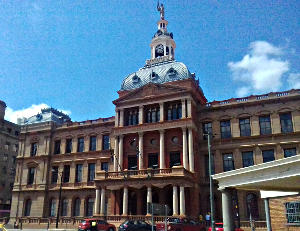The Ou Raadsaal on Church Square, Pretoria: A Monument of History and Architecture
Situated in the South-west corner of Church Square, Pretoria, the Ou Raadsaal remains a testament to the evolving political, economic, and architectural legacy of South Africa. The oldest surviving edifice on the Square, its construction was a symbol of the newly acquired stature of the Transvaal government, largely attributable to the gold discovery on the Witwatersrand.
Before the magnificent Renaissance Revival styled building graced Church Square, the site was home to a humbler structure: a thatch-roofed cottage that acted as the previous Raadsaal (Council Chambers). This cottage was in use until its demolition in 1889 to pave the way for the grander Government Building.
The commission for the Ou Raadsaal came in the late 19th century by the South African Republic, desiring a more appropriate seat of government in Pretoria. Entrusted to the Dutch architect Sytze Wierda, the initial design encompassed only two floors. However, legend has it that President Paul Kruger, upon learning that the President Hotel across the Raadsaal was to be three stories, demanded the same for the new building. Thus, during the annual sitting of the Volksraad in 1890, the decision was made to add a third floor.
Noteworthy is the contribution of John Johnstone Kirkness, the builder from the Orkney Islands who undertook the project for £82,500. Despite logistical challenges, including transporting materials and specialized items from Durban, the construction proceeded at a commendable pace. The foundation stone was laid by President Kruger in 1889, and by December 1891, the structure was completed. An impressive feat, given the scale and intricacy of the design.
The finished Raadsaal was an epitome of modernity for its time. Telephones were promptly installed in 1892, with electric lighting following in 1896. The clock tower, with its distinct chiming patterns, was equipped with four bells in 1893, the largest bearing the inscription 'Staatspresident Paul Kruger'. This clock tower, though a marvel, wasn't without its critiques, notably from Mark Twain and Rudyard Kipling, who remarked on its peculiar chime during their respective stays at the President Hotel.
Another significant occupant of the building was the Transvaal Museum. Established in 1892 on the top floor, it soon had to relocate owing to space constraints, a testament to the Museum's growing collection and popularity.
The Ou Raadsaal has undergone renovations, first in 1962 and later in 1989. In recognition of its historical significance, it was declared a national monument in 1968 and a Provincial Heritage Site in 1999.
Originally intended to accommodate various government offices, the building soon became the hub of political activity, housing the Volksraad, the parliament of the South African Republic, from 1891 to 1902. However, post the Second Boer War and the subsequent annexation of the South African Republic by the United Kingdom, the Ou Raadsaal lost its primary purpose.
The architectural marvel stands today not just as a building but as a repository of stories, legends, and the rich tapestry of South African history. Whether it's the doors and windows crafted in the Orkney Islands and painstakingly transported or the tales of famous writers vexed by its clock tower, the Ou Raadsaal remains an enduring monument to South Africa's past, present, and future.
Further Reading
For further insights into the 'Ou Raadsaal', explore these resources:
